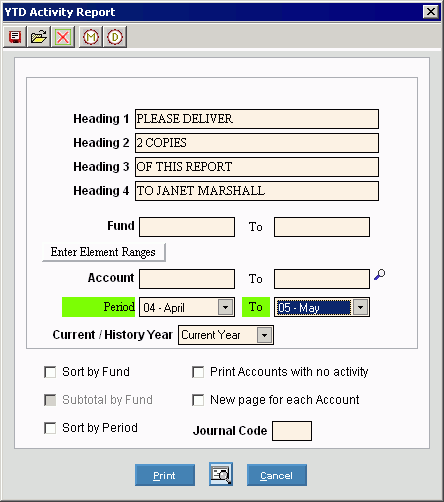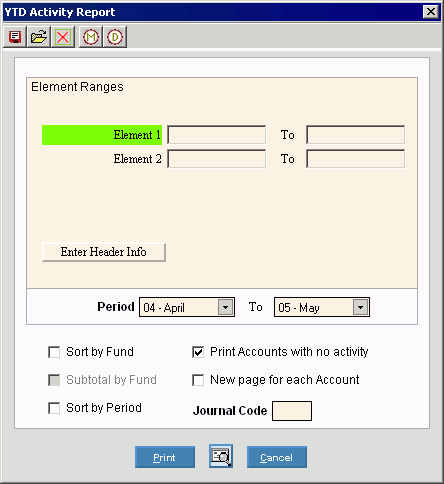Opening the YTD Activity Report, click More.
-
Basic Method (from the G/L Module):
-
Click Reporting from the Menu Bar.
-
Click YTD Activity Report.
Tip: Or, use the keyboard shortcut: [ALT] [r] [a].
-
Advanced Method (from another NDS Module):
-
Click General Ledger from the Menu Bar.
-
Click Reporting.
-
Click YTD Activity Report.
Tip: Or, use the keyboard shortcut: [ALT] [g] [r] [a].
Note: To activate the General Ledger menu in another module, the G/L Application Control must be set up for the module during installation.
YTD Activity Report - Header Window Example:

YTD Activity Report - Element Range Window Example:

Choosing the selections at the prompt window, click More.

|
YTD Activity Report Prompt Options Tip: To see more information about a field, click the hyperlink for the field name. | |
|
Header Information Prompt | |
|
Enter the first line of text that you want to appear at the top of the report. Tips:
| |
|
Enter the second line of text that you want to appear at the top of the report. (up to 30 characters) Tips:
| |
|
Enter the third line of text that you want to appear at the top of the report. Tips:
| |
|
Enter the fourth line of text that you want to appear at the top of the report. Tips:
| |
|
Fund Range |
To limit the report to a range of Funds, enter the from and to Funds (inclusive). (4.0 numeric) Tip: To select all Funds, leave blank. |
|
|
To limit the report to a range of Account Elements, click Enter Element Ranges. Note: You will see the Element Range Prompt, which is described below. |
|
Account Range |
To limit the report to a range of Account Numbers, enter the from and to Account Numbers (inclusive). (format varies) Tips:
|
|
Period Range |
To limit the report to a range of Periods (inclusive), click the from and to Periods in the drop-down lists. (predefined) Required |
|
Current / History Year |
To specify which Fiscal Year to include in the report, click one of the following options in the drop-down list:
|
|
Sort by Fund |
To specify if you want to sort the report by Fund: Tip: The default sort sequence for the report is by Account Number. |
|
Subtotal by Fund |
To specify if you want to subtotal by Fund:
Tip: The Subtotal option is available only if you sort by Fund. |
|
Sort by Period |
To specify if you want to sort the report by Period:
Tip: The default sort sequence is by Account Number. |
|
Print Accounts With No Activity |
To specify if you want to print accounts with no activity:
|
|
New Page for Each Account |
To specify if you want to print each account on a new page:
|
|
To limit the report to a specific Journal Code, enter a valid Journal Code. (up to two characters, predefined) Tip: To select all Journal Codes, leave blank. | |
|
|
To begin printing to the Windows® default printer, click Print, or press [ENTER]. Keyboard shortcut: [ALT + p] |
|
|
To print to the Print View screen, click here. |
|
|
To escape from the print routine, click Cancel. Keyboard shortcut: [ALT + c] |
|
Element Range Prompt Tip: This prompt displays a list of the Elements defined for the Account Number. The list of elements varies according to the settings for each facility. You can select accounts to print on the report by entering ranges of Elements. | |
|
Element Ranges |
To select accounts by Element to be included in the report, enter the from and to values for each applicable Element (inclusive). (format varies) |
|
|
To display the Header Information prompt, click Enter Header Info. |
Report Sample(s), click More.




